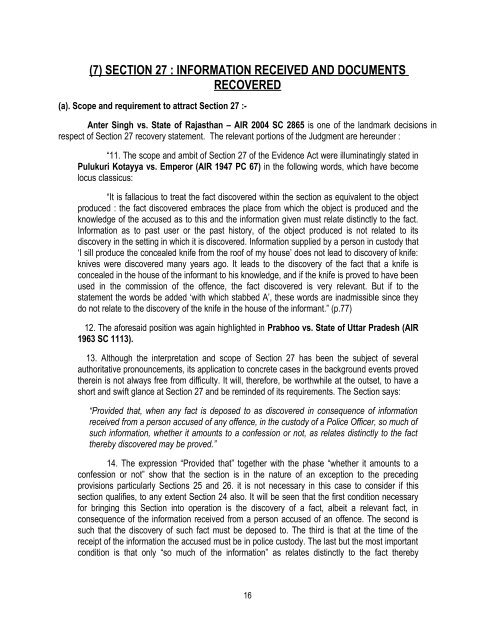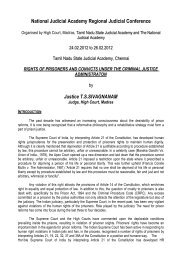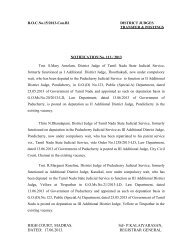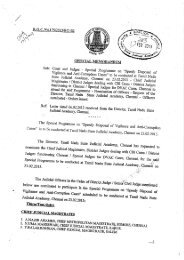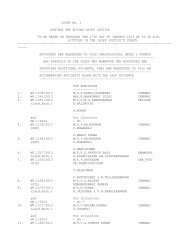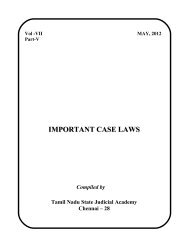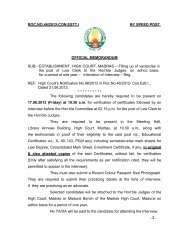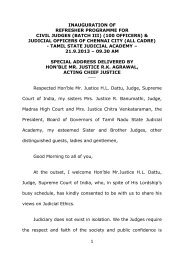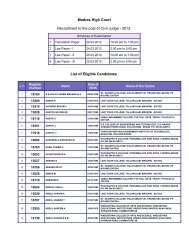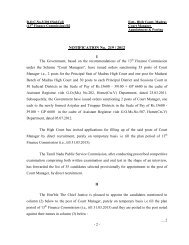Appreciation of Evidence in Sessions Cases - Justice D.Murugesan
Appreciation of Evidence in Sessions Cases - Justice D.Murugesan
Appreciation of Evidence in Sessions Cases - Justice D.Murugesan
Create successful ePaper yourself
Turn your PDF publications into a flip-book with our unique Google optimized e-Paper software.
(7) SECTION 27 : INFORMATION RECEIVED AND DOCUMENTS<br />
RECOVERED<br />
(a). Scope and requirement to attract Section 27 :-<br />
Anter S<strong>in</strong>gh vs. State <strong>of</strong> Rajasthan – AIR 2004 SC 2865 is one <strong>of</strong> the landmark decisions <strong>in</strong><br />
respect <strong>of</strong> Section 27 recovery statement. The relevant portions <strong>of</strong> the Judgment are hereunder :<br />
“11. The scope and ambit <strong>of</strong> Section 27 <strong>of</strong> the <strong>Evidence</strong> Act were illum<strong>in</strong>at<strong>in</strong>gly stated <strong>in</strong><br />
Pulukuri Kotayya vs. Emperor (AIR 1947 PC 67) <strong>in</strong> the follow<strong>in</strong>g words, which have become<br />
locus classicus:<br />
“It is fallacious to treat the fact discovered with<strong>in</strong> the section as equivalent to the object<br />
produced : the fact discovered embraces the place from which the object is produced and the<br />
knowledge <strong>of</strong> the accused as to this and the <strong>in</strong>formation given must relate dist<strong>in</strong>ctly to the fact.<br />
Information as to past user or the past history, <strong>of</strong> the object produced is not related to its<br />
discovery <strong>in</strong> the sett<strong>in</strong>g <strong>in</strong> which it is discovered. Information supplied by a person <strong>in</strong> custody that<br />
‘I sill produce the concealed knife from the ro<strong>of</strong> <strong>of</strong> my house’ does not lead to discovery <strong>of</strong> knife:<br />
knives were discovered many years ago. It leads to the discovery <strong>of</strong> the fact that a knife is<br />
concealed <strong>in</strong> the house <strong>of</strong> the <strong>in</strong>formant to his knowledge, and if the knife is proved to have been<br />
used <strong>in</strong> the commission <strong>of</strong> the <strong>of</strong>fence, the fact discovered is very relevant. But if to the<br />
statement the words be added ‘with which stabbed A’, these words are <strong>in</strong>admissible s<strong>in</strong>ce they<br />
do not relate to the discovery <strong>of</strong> the knife <strong>in</strong> the house <strong>of</strong> the <strong>in</strong>formant.” (p.77)<br />
12. The aforesaid position was aga<strong>in</strong> highlighted <strong>in</strong> Prabhoo vs. State <strong>of</strong> Uttar Pradesh (AIR<br />
1963 SC 1113).<br />
13. Although the <strong>in</strong>terpretation and scope <strong>of</strong> Section 27 has been the subject <strong>of</strong> several<br />
authoritative pronouncements, its application to concrete cases <strong>in</strong> the background events proved<br />
there<strong>in</strong> is not always free from difficulty. It will, therefore, be worthwhile at the outset, to have a<br />
short and swift glance at Section 27 and be rem<strong>in</strong>ded <strong>of</strong> its requirements. The Section says:<br />
“Provided that, when any fact is deposed to as discovered <strong>in</strong> consequence <strong>of</strong> <strong>in</strong>formation<br />
received from a person accused <strong>of</strong> any <strong>of</strong>fence, <strong>in</strong> the custody <strong>of</strong> a Police Officer, so much <strong>of</strong><br />
such <strong>in</strong>formation, whether it amounts to a confession or not, as relates dist<strong>in</strong>ctly to the fact<br />
thereby discovered may be proved.”<br />
14. The expression “Provided that” together with the phase “whether it amounts to a<br />
confession or not” show that the section is <strong>in</strong> the nature <strong>of</strong> an exception to the preced<strong>in</strong>g<br />
provisions particularly Sections 25 and 26. it is not necessary <strong>in</strong> this case to consider if this<br />
section qualifies, to any extent Section 24 also. It will be seen that the first condition necessary<br />
for br<strong>in</strong>g<strong>in</strong>g this Section <strong>in</strong>to operation is the discovery <strong>of</strong> a fact, albeit a relevant fact, <strong>in</strong><br />
consequence <strong>of</strong> the <strong>in</strong>formation received from a person accused <strong>of</strong> an <strong>of</strong>fence. The second is<br />
such that the discovery <strong>of</strong> such fact must be deposed to. The third is that at the time <strong>of</strong> the<br />
receipt <strong>of</strong> the <strong>in</strong>formation the accused must be <strong>in</strong> police custody. The last but the most important<br />
condition is that only “so much <strong>of</strong> the <strong>in</strong>formation” as relates dist<strong>in</strong>ctly to the fact thereby<br />
16


